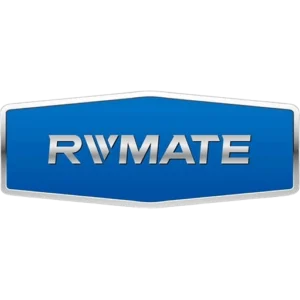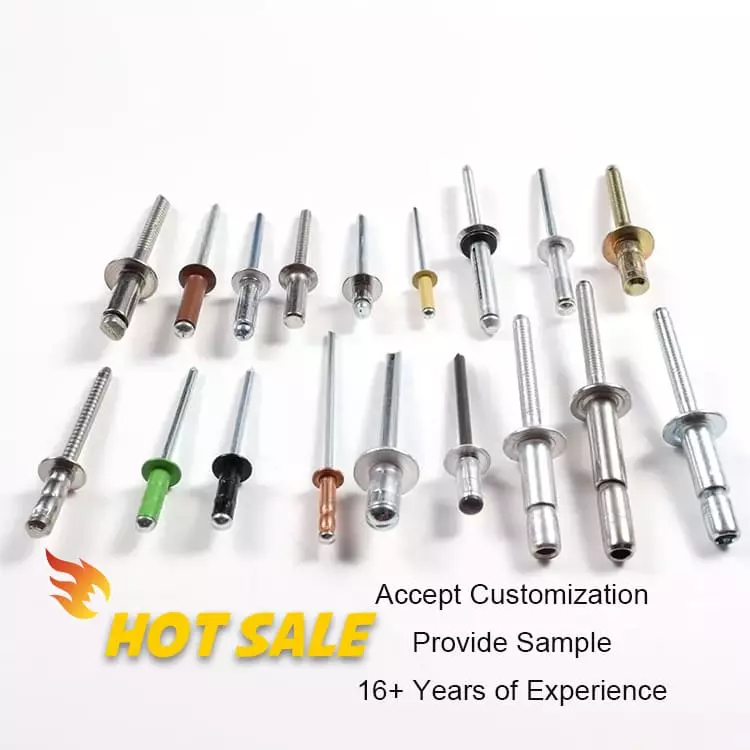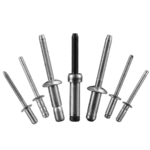Do Pop Rivets Leak? - The Comprehensive Guide
Table of Contents
In many industrial and structural assembly fields, blind rivets are widely used in outdoor equipment, sheet metal shells, marine structures, electrical enclosures, HVAC systems, and other types of working conditions due to their ease of operation, reliable connections, and suitability for single-sided installation. However, with the diversification of application environments, especially in scenarios involving high sealing requirements such as waterproofing, dustproofing and corrosion protection. Many engineers, assembly technicians and maintenance personnel ask the key question, “Do Pop Rivets Leak?”
This question seems simple, but actually involves structural design, material compatibility, rivet type, installation process, tolerance control and other professional dimensions. Many connection structures in the actual operation of water seepage, condensation or even corrosion phenomenon, the root cause is often related to the rivets sealing ability is insufficient.
Do Pop Rivets Leak?
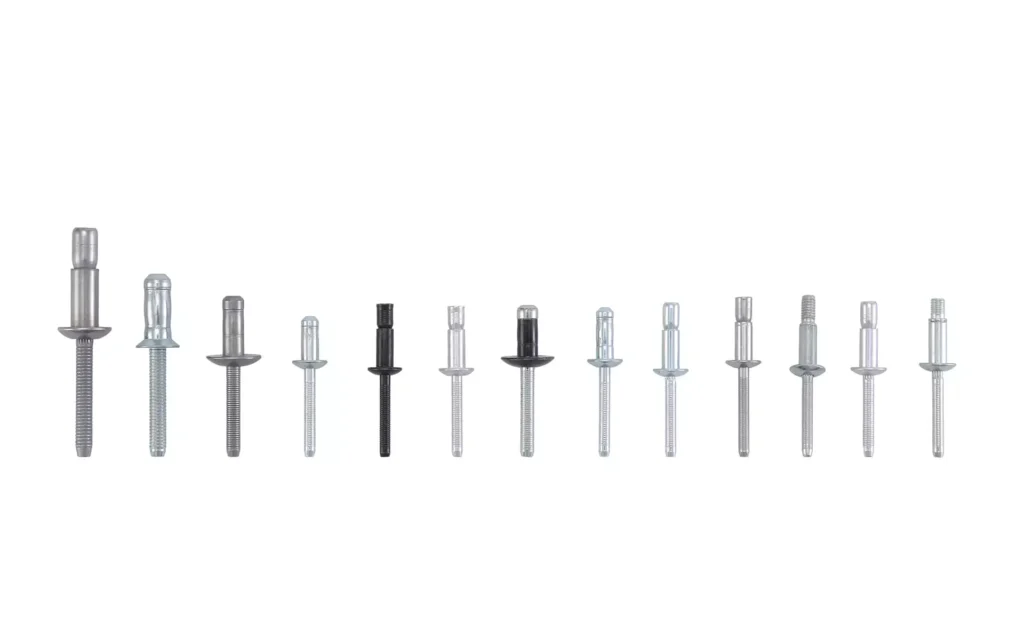
Not all pop rivets are waterproof. Different rivet types vary significantly in construction, resulting in vastly different water resistance capabilities.
1) Standard Open-End Pop Rivets Will Leak
Open-end pop rivets feature an exposed tail end. After the mandrel breaks off, a through-hole remains, allowing rainwater and moisture to enter through gaps and openings. Consequently, open-end rivets cannot structurally achieve waterproofing and are suitable for indoor use or environments where sealing isn’t required.
(2) Closed-End Pop Rivets Prevent Leaks and Provide Complete Sealing
Closed-end blind rivets feature a sealed bottom. After the mandrel breaks, it remains locked within the cap, eliminating any potential water pathways. In roofing, exterior walls, HVAC, and similar industries, closed-end rivets deliver effective waterproofing. Rivmate testing confirms zero leakage even under high water pressure.
(3) Rivets with EPDM Gaskets Offer Superior Waterproofing
Some rivet heads incorporate EPDM waterproof gaskets. These gaskets fill micro-gaps between the hole and rivet to prevent water ingress and resist loosening due to thermal expansion and contraction. Such rivets are commonly used in outdoor panel overlaps, door/window systems, and equipment enclosures.
(4) Primary Causes of Pop Rivet Leakage
Leaks typically originate from three points: the mandrel breakout hole, the open end of the cap, and gaps between the hole and the rivet. Over-drilled holes, uneven panels, or insufficient clamping during installation can also cause leakage. Therefore, selecting the correct rivet design and ensuring proper installation quality are equally critical.
Why Some Pop Rivets Leak?
Blind rivets are blind riveted joints consisting of two parts: the rivet body and the rivet mandrel. during installation, the rivet body is inserted into a pre-drilled hole, and the rivet mandrel is pulled by the rivet gun, which causes the tail to plastically deform and compresses the connected sheet material. Once the tension reaches a certain threshold, the rivet mandrel breaks at the pre-determined position, remaining inside the rivet or falling off, thus completing the one-time connection.
Blind Rivets Sealing Principle
Structurally, standard open end blind rivets are not naturally waterproof. There are several main potential leakage paths:

- The rivet mandrel channel runs through the entire rivet body: an open aperture is formed at the break after installation, and even if part of the rivet mandrel remains in the rivet, it does not completely seal the channel, and liquids or moisture can penetrate through it.
- Tiny gap between the plate and the rivet: no matter how accurate the machining is, it is difficult to achieve 100% tight contact between the hole wall and the rivet body.
- Material springback due to metal deformation in the expansion zone: The expansion and deformation of the rivet body tail during the riveting process can lead to a certain amount of material springback and the formation of micro-seam structures. This is more obvious in multi-layer material connection.
- Thermal expansion and contraction and air pressure difference: environmental changes (such as high temperature → cooling) will lead to material contraction, triggering the original compression area to produce stress release, thus triggering leakage.
Therefore, unless a special structural design or additional sealing material processing, the standard pop rivet is not equivalent to waterproof rivet, which is why in the project with a clear sealing requirements, can not simply use conventional rivets, but must choose to have a closed structure or sealing gasket rivet type. At the same time, the sealing performance of the rivet not only depends on the rivet itself, but also need to take into account the quality of hole processing, installation process and material matching and other aspects.
What types of pop rivet are leak-proof?

Structural features: the bottom of the cap body of the rivet is completely closed design. Even after the rivet mandrel breaks, the interior will not form a through hole, effectively preventing water, gas, oil penetration through the rivet center shaft. Most closed type rivets also have high shear and tensile strength.
Application Scenarios:
- Electronic housings, watertight housings, hydraulic equipment
- Outdoor lighting, meter boxes, control cabinets
- Any sheet metal structure that is sensitive to liquid or moisture penetration.
b. Sealed Blind Rivet with EPDM/NBR Washer
Structural features: In the ordinary blind rivet cap to add a ring of high elasticity waterproof washer (common materials for EPDM, nitrile rubber, etc.). In the riveting process, the washer will be pressed on the joint surface, sealing the hole, effectively preventing liquid penetration through the hole wall gap.
Application Scenario:
- Air conditioner shells, refrigerator panels, outdoor hoods
- Rain gutters, aluminum composite panel curtain walls, traffic signs
- Structural components requiring primary sealing in low and medium pressure environments

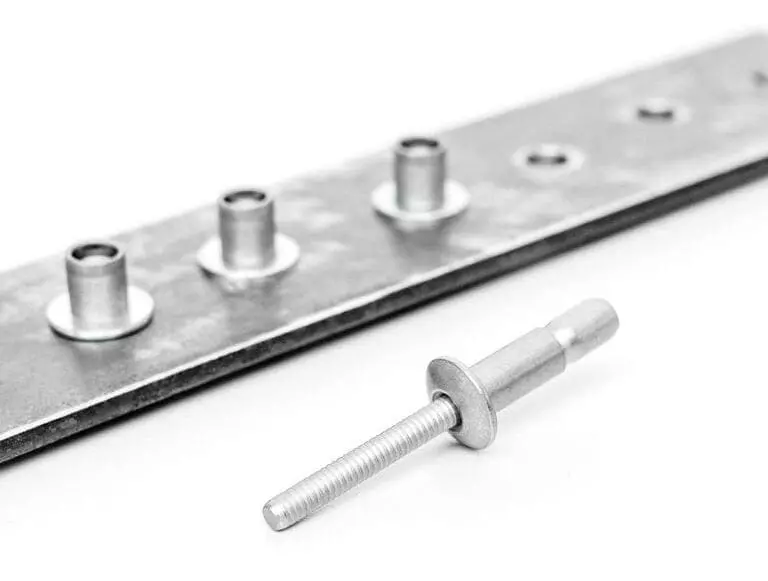
Structural Features: Combines a structural rivet with a sealing feature. Typically with a high tensile strength design (for high load connections), with a locking core mechanism and metal/glue encapsulation components to keep the entire rivet system highly dense and closed after the completion of the core break.
Application Scenario:
- Heavy-duty equipment, watertight pressure chambers, truck compartment floors
- Bridge components, ship structure, wind turbine nacelle outer cover
- Composite joints that require high strength + corrosion resistance + sealing performance
Rivet Waterproof Performance Comparison Table
| Rivet Type | Leak-Proof Rating | Typical Use Case |
|---|---|---|
| Open-End Blind Rivet | ✘ No | Basic sheet metal, no waterproofing |
| Closed-End Blind Rivet | ✓ Partial (IP65) | Control boxes, HVAC ducts, LED housing |
| Sealed Rivet with Washer | ✓ Good Surface Seal | Outdoor enclosures, appliance panels |
| Structural Sealed Rivet | ✓✓ Full Seal (IP67/IP68) | Vehicle frames, marine, heavy equipment |
How to choose a riveted joint that is not susceptible to water penetration?
Choosing the right type of rivet is only the first step when designing or repairing a structure that needs to be watertight, dusttight or corrosion resistant. The real realization of watertight riveted joints must also be combined with the actual use of the scene and the correct installation standards. The following are representative of the use of engineering practice and the corresponding practical suggestions:
1. Define the environment of use: outdoor exposure ≠ humid intervals ≠ waterlogged confinement.
Different environments have different definitions of “waterproof”. For example, an outdoor communication box only needs to withstand rain, so rubber gasket type rivets can be used. For an air conditioning enclosure that needs to prevent condensation from flowing back in, it is recommended to use closed type rivets. If it involves a long time underwater use (such as the hull of the ship, diving equipment), it must be used structural sealing type rivets + panel sealant composite program, and IP rating test.
2. Hole size control is key: interference fit is better than loose fit

The sealing ability of blind rivets is highly dependent on the tolerance of the hole diameter. Recommended hole diameter should be slightly larger than the diameter of the rod 0.1-0.2 mm, to ensure that the deformation section fully affixed to the wall of the hole, to avoid the emergence of gaps. If the hole is too large, the deformation is not uniform, will lead to cap sealing failure, the gasket can not be fully compressed, thus forming a water seepage path.
Rivet hole diameter standard can refer to “ Metric Blind Pop Rivet Hole Size Chart ”.
3. When selecting gasket type rivets, check the gasket material and compression status.
It is recommended to use EPDM or Nitrile Rubber (NBR) for the gasket, taking into account the weather resistance and resilience. When installing, use a rivet gun with clamping torque control or a tension feedback tool to ensure even pressure on the gasket. If a pneumatic rivet gun is used and no limit is set, it is easy to press through the gasket due to excessive core pulling, resulting in seal failure.
4. Recommended auxiliary sealant for composite structures
For multi-layer metal, metal + plastic, coated sheet and other joint structures, even if closed type rivets are used, a ring of sealant (e.g. butyl, silicone) should be applied around the rivet holes before installation. This can enhance the watertightness of the interface, to avoid the risk of long-term leakage due to the rebound of the material, the warping of the inter-layer plate.
5. Establishment of installation process standardization
It is recommended that companies implement the following SOP process for products with waterproofing requirements:
- Rivet type and hole size preset table.
- Rivet position inspection + photo archive before sealing.
- Regular use of water spray test, air tightness test or salt spray test to verify the sealing performance.
- Set up installation feedback record mechanism (rivet gun feedback tension, broken core monitoring).
Choosing a waterproof pop rivet is just the foundation; ensuring the accuracy of the hole diameter, using the right gasket and sealant, and standardizing the installation process are the guarantees for building a truly watertight structure. For enterprises, this is not only about product performance, but also directly affects customer trust and later maintenance costs.
Where Waterproof Rivets Are Required?
Metal Roofing
Roofing systems endure prolonged exposure to rainwater, wind pressure, and temperature fluctuations. Open-ended rivets allow rainwater to gradually seep through rivet holes and lap joints, leading to moisture penetration of insulation layers, corrosion of steel structures, and even leakage complaints. Therefore, metal roofs typically employ closed-head rivets + EPDM washers.
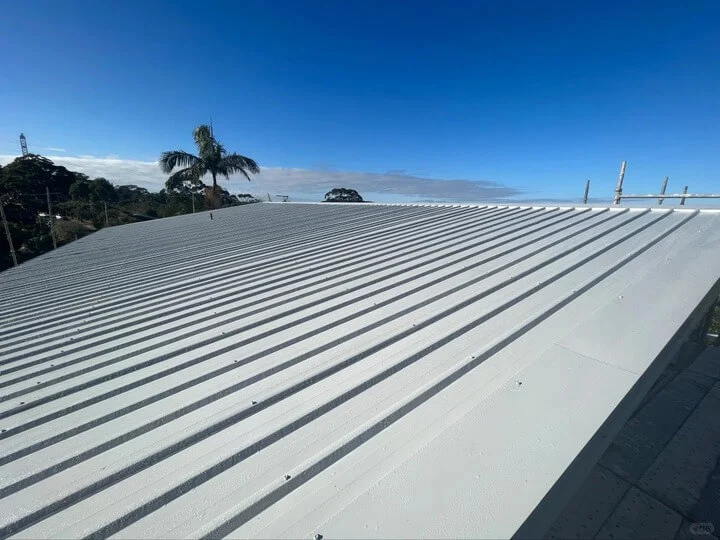
Cladding / Facade Systems
Curtain walls and metal cladding panels must not only prevent rainwater penetration into the wall structure but also block moisture intrusion into the insulation layer. Leakage around rivets can cause wall mold, insulation failure, and even compromise structural longevity. Professional facade systems therefore employ waterproof rivets or sealed riveting solutions.
HVAC Housings & Ducting
Condensation and pressure fluctuations exist inside and outside air conditioning units, heat exchanger housings, and ductwork. If rivets are not sealed, condensation can infiltrate the interior, corroding fans, motors, or control components. Waterproof rivets reduce maintenance frequency and enhance equipment reliability.
Truck Bodies / Trailers / Bus Panels

Truck bodies, trailers, and bus panels endure prolonged exposure to rainwater, muddy water, and road spray. Non-waterproof rivets allow water ingress into the sandwich layers, causing steel plate corrosion and wooden floor rot, shortening vehicle lifespan. Consequently, body manufacturers predominantly use closed-head or structural waterproof rivets.
Marine & Outdoor Equipment
Marine equipment, dock facilities, outdoor enclosures, and mounting brackets endure high salt spray and humidity. Water ingress at rivet points allows corrosion to rapidly spread around the hole. These applications typically require stainless steel waterproof rivets + sealing washers to ensure long-term stability.
Frequently Asked Questions About Pop Rivet Waterproofing
Q1. Do pop rivets leak?
Yes, they can leak. Most open-end pop rivets do not inherently possess a sealing structure. The hole left where the mandrel breaks allows water to seep in along that point.
Only closed-end rivets or rivets with sealing washers provide true waterproofing.
Q2. Are pop rivets watertight?
Not all pop rivets are watertight. Standard open-end rivets are not watertight; only closed-end rivets provide a water and vapor seal. For applications like roofing, exterior walls, or outdoor equipment, Closed-End Rivets + EPDM gaskets must be used to achieve a long-term seal.
Q3. How to waterproof a pop rivet?
Three most effective methods:
- Use Closed-End Blind Rivets
- Add EPDM / Neoprene waterproof washers to the rivet head
- Enhance sealing at the hole with sealant or Butyl Tape
Combining these three methods achieves waterproofing close to IPX7 level.
Q4. What rivets are best for metal roofing?
Metal roofing requires waterproof rivets. Rivmate recommends:
- Closed-End Blind Rivet + EPDM Washer
- Prioritize Aluminum Cap + Stainless Steel Core (Al/SS) or all-stainless steel construction
- UV-resistant EPDM washers enhance longevity
This represents the industry’s most versatile and reliable roofing fastening solution.
Conclusion: How to Choose Leak-Proof Pop Rivets?

To prevent water seepage, the key lies not in the “rivet brand” but in selecting the correct structural type. Different environments demand varying levels of waterproofing, so the rivet structure must match the application scenario. Below are the most practical selection principles engineers have identified based on extensive project experience:
1. Outdoor Environments → Use Closed-End Rivets
Outdoor structures endure prolonged exposure to rain and moisture. Standard open-end rivets are prone to water ingress through the hole at the mandrel break point. Closed-end rivets feature a fully sealed bottom, effectively blocking moisture penetration. They are the fundamental choice for all outdoor applications.
2. Roofing Systems → Closed-End Rivets + EPDM Washers
Metal roofs and exterior walls demand the highest waterproofing standards. We recommend closed-end rivets paired with EPDM waterproof washers. EPDM resists UV exposure, temperature fluctuations, and aging, maintaining reliable waterproofing for over a decade. This combination is the industry standard for roofing.
3. High-Strength Applications → Structural Waterproof Rivets
Structures like vehicle bodies, machinery housings, and control cabinets endure vibration and load. These scenarios demand not only waterproofing but also high shear resistance and vibration tolerance. Structural waterproof rivets feature mechanical locking mechanisms to ensure long-term stability without loosening, offering a safer solution.
4. Indoor Applications → Open-End Rivets (Highest Cost-Effectiveness)
For indoor sheet metal, enclosures, furniture hardware, and similar scenarios without waterproofing requirements, open-end rivets offer the lowest cost, fastest installation, and excellent compatibility. They provide stable connection performance in dry environments.
Get Waterproof Rivet Solutions for Your Project

If you’re seeking a waterproof rivet solution that is truly leak-proof, stable, reliable, and built for long-term use, Rivmate’s engineering team can provide comprehensive technical support. We not only supply samples of waterproof structural blind rivets but also perform hole diameter and clamping force verification based on your panel thickness and structural requirements, ensuring optimal riveting performance.
We simultaneously provide ISO-compliant test data, giving you greater confidence in project evaluation and quality validation. For projects requiring long-term supply or branded packaging, we also support OEM packaging, annual supply agreements, and inventory management services.
Contact Rivmate today and eliminate concerns about leaks, fatigue, or unstable assemblies in your projects.
📧 Product Inquiry: manufacture@world-rivet.com
🌐 Official Website: https://worldrivet.com/
reference

How to Rivet Metal to Wood?
How to Rivet Metal to Woo

What Is Riveting in Metal Work?
What Is Riveting in Metal
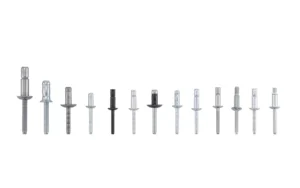
What Metal Are Rivets Made Of
What Metal Are Rivets Mad
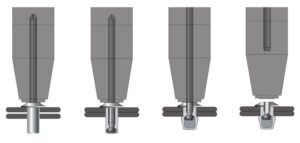
How to Rivet Metal to Metal
How to Rivet Metal to Met
